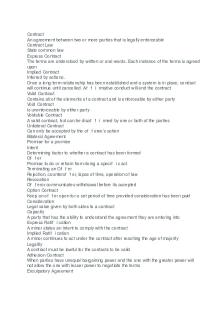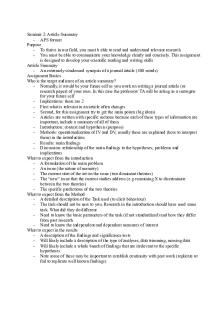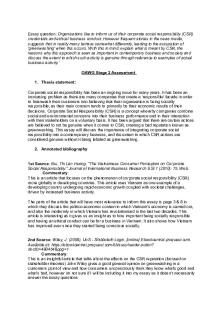Session 2 - Lecture notes 2 PDF

| Title | Session 2 - Lecture notes 2 |
|---|---|
| Author | Haley Allen |
| Course | Introductory Sociology |
| Institution | University of Ontario Institute of Technology |
| Pages | 13 |
| File Size | 412.3 KB |
| File Type | |
| Total Downloads | 75 |
| Total Views | 152 |
Summary
sociology through the years...
Description
Chapter 1 – review Evolution of Sociological Imagination 1. Scientific Revolution (circa 1550) •
Suggested the possibility of a science of society
2. Democratic Revolution (circa 1750) •
Suggested that people could intervene to improve society
3. Industrial Revolution (circa 1775) •
Presented social thinkers with social problems that required solutions
Outcome – birth of the sociological imagination (seeing the connection between personal problems and social structures)
Social structure: Relatively stable patterns of social relations. Four levels of social structure: i.
Microstructures: patterns of intimate social relations formed during faceto-face interaction.
ii.
Mesostructures: patterns of social relations within organizations.
iii.
Macrostructures: patterns of social relations outside and above one’s circle of intimates and acquaintances.
iv.
Global structures: patterns of social relations outside and above the national level.
The four theoretical traditions especially influential in the development of sociology: 1.
Functionalism: How is social order supported by macrostructures?
2. Conflict Theory: How is social inequality maintained and challenged? 3. Symbolic Interactionism: How do people create meaning when they communicate in micro-level settings? 4. Feminism: What are the social sources of patriarchy in both macro and micro settings?
Conducting Research 1. Formulate research questions 2. Review existing research literature 3. Select research method 4. Collect data 5. Analyze data 6. Publish results Chapter Two 1.
Define culture and its main functions.
2.
Explain how culture helps humans adapt and thrive in their environments.
3.
Recognize how culture can make people freer.
4. 5.
Analyze the ways in which culture is becoming more diverse, multicultural, and globalized. Recognize how culture can place limits on people’s freedom.
6.
Hopefully have a conversation around Consumerism and genuine happiness!?? What is this “happy” thing?
Culture as Problem Solving The sum of practices, languages, symbols, beliefs, values, ideologies, and material objects that people create to deal with real-life problems. “Culture influences the lifestyle, and the lifestyle influences the way we communicate” (Vittorio Colao) •
Culture is the means humans use to solve the challenges of life.
•
Humans turn to their culture for solutions.
•
At the root of culture is solving the problem of meaning.
Culture -
The shared symbols and their definitions that people create to solve real-life problems.
-
Enables people to adapt to, and thrive in, their environments.
Symbols -
Are concrete things or abstract terms that represent something else.
-
Symbols are shared.
What does a cell phone have to do with culture? Are you guilty of nocialzing The power of culture is that it makes our sensory experiences meaningful. Once your cultural experience conditions you to interpret concrete experiences a certain way, this becomes your reality.
High culture -
Culture consumed mainly by upper classes.
-
Examples? Is high culture by definition elitist?
Popular culture -
Culture consumed by all classes.
-
“Popular culture consists of the aspects of attitudes, behaviors, beliefs, customs, and tastes that define the people of any society. Popular culture is, in the historic use of the term, the culture of the people.” - Ray Browne
-
Examples of popular culture?
Society -
A number of people who interact, usually in a defined territory, and share a culture
The Origins and Components of Culture The Human Cultural Survival Kit 1. Abstraction a. The ability to create general concepts that meaningfully organize concrete, sensory experience. b. Ideas, symbols (nonmaterial culture) 2. Cooperation a. Capacity to create a complex social life by establishing generally accepted ways of doing things and ideas about what is right and wrong. b. Norms and values Folkways – social preferences Mores – social requirements Taboos Establish… i. Norms, which are standards of behaviour or generally accepted ways of doing things; and ii. Values, or ideas about what is right and wrong, good and bad, beautiful and ugly.
3. Production a. Human capacity to make and use tools, and thereby improve our ability to take what we want from nature. b. Material culture, tools and techniques
In medicine for example…
Culture consists of the shared symbols and their definitions that people create to solve real life problems and that give human life meaning. Culture supports human adaptation to the environment by means of abstraction, cooperation and production.
Language and the Sapir-Whorf Thesis -
Language: A system of symbols strung together to communicate thought.
-
Language is a primary carrier of culture.
-
Sociologists’ claim that language is a cultural invention is disputed by some scientists who believe language is instinctual, not cultural.
1. Experience a. We experience certain things in our environment and form concepts about those things. 2. Conceptualization (thought) a. We then develop language to express our concepts. 3. Verbalization (language) a. Finally, language itself influences how we see the world.
-
The degree to which language itself influences thought is a matter of controversy.
What effect does language have on culture? “Fox, babe, bitch, ho, and doll” -- What terms do females use in reference to men?-“You play like a girl …” -- What does that mean? -- “The promotion / teaching of “tolerance”… What does that imply?
A Functionalist Analysis of Culture The Sacred Rac What are the manifest (intended and easily observed) and latent (unintended and less obvious) consequences of the Asu honouring their sacred rac? Which cultural practice—that of the Hindu cow worshipping peasants in India or that of the Asu tribe—is ‘more bizarre’? Many Westerns find the Indian practise of cow worship bizarre. However, cow worship performs a number of useful economic functions and is in that sense entirely rational. As an ‘outsider’ we fail to see its rational core. Culture and Ethnocentrism Ethnocentrism: The tendency to judge other cultures exclusively by the standards of our own culture. -
making assumptions about others’ ways based on our own limited experience
-
People tend to take their culture for granted.
-
The ideas, norms, and techniques of other cultures frequently seem odd, irrational, and even inferior. Culture as Freedom Culture has two faces:
1. Provides us with an opportunity to exercise our freedom. 2. Puts limits on what we can think and do - culture constrains us. Symbolic Interactionism and Cultural Production: -
Culture is viewed as an independent variable.
-
People do not just accept culture passively; we are not empty vessels into which society pours a defined assortment of beliefs, symbols, and values.
-
Instead, we produce and interpret culture, creatively fashioning it to suit our diverse and changing needs.
Multiculturalism -
Cultural diversity in Canada has increased in Canada greatly (1960 2016)
Policy of Canada: -
Multiculturalism reflects the cultural and racial diversity of Canadian society.
-
All members of Canadian society are free to preserve, enhance, and share their cultural heritage.
-
Multiculturalism is an invaluable resource in the shaping of Canada’s future.
Advocates: -
The cultural bias of some school curricula needs to be addressed to properly reflect a multicultural Canada.
Critics: -
Immigration and multi-culturalist policies weaken Canada’s social fabric. o Promotes cultural relativism
Encourages respect for practices that are abhorrent to most Canadians
Discussion: -
Immigrating to a multicultural Canada: Is immigration a two-way street?
-
Whereby the host country accommodates and welcomes newcomers, while the newcomers also make attempts to integrate and accept that not everything will be the same as in the country that they left.
Rights Revolution The process by which socially excluded groups have struggled to win equal rights under the law and in practice. 1. Spurred by the 1948 United Nations Universal Declaration of Human Rights 2. Rights revolution in full swing by 1960s 3. Resulted in ever-widening and deepening democracy for increasing numbers of citizens The rights revolution fragments Canadian culture by: 1. Legitimizing the grievances of groups that were formerly excluded from full social participation. 2. Renewing their pride in their identity and heritage. To what extent are today’s citizens obligated to pay for the discriminatory practices that were carried out by citizens of previous generations?
Some members of groups subjected to high levels of discrimination historically (e.g., Aboriginal Canadians, Chinese Canadians) are demanding reparations in the form of money, symbolic gestures, land, and political autonomy. Problem: Determining extent to which today’s citizens are obligated to repay past injustices.
From Diversity to Globalization Globalization: -
The process by which formerly separate economies, states, and cultures are tied together and people become aware of their growing interdependence.
-
One of most important roots of globalization is expansion of international trade and investment.
Rites of Passage: -
Cultural ceremonies that mark the transition from one stage of life to another.
Culture is homogeneous -
What ‘rites of passage’ have you personally experienced or witnessed?
Culture increasingly fragmented: 1. Pre-industrial Western Europe and North America 2. Industrialization 3. Globalization
Effect of globalization: Breaks down political, economic, and cultural isolation.
People: 1. Are less obliged to accept the culture into which they were born. 2. Are freer to combine elements of culture from a variety of historical periods and geographical settings. 3. Can group together in a “global village” (Marshall McLuhan).
Modernism (era of modernity):
Postmodernism (culture of our times): 1. An eclectic mix of cultural elements from different times and places
1. Belief in the inevitability of progress 2. Respect for authority
2. The erosion of authority
3. Consensus around core values
3. Decline of consensus around core values
Postmodernism 1. Blending Cultures a. A mixing of diverse elements from different times and places. What cultures do you consume? (Consider the food industry in Canada).
d. Religion and Religious Leaders Should those in positions of authority be questioned?
2. Erosion of Authority a. Parents b. Doctors c. Politicians
3. Instability of Core Values a. Rapid value shifts and erosion of consensus in many areas: i. political party loyalty ii. loss of consensus in ‘big historical projects’ German Nazism - Russian communism - Progress as inevitable and ongoing improvement of life due to spreading democracy and scientific advances Is Canada the First Postmodern Country? In comparison to Americans, Canadians are… Less likely •
to express confidence in big business
•
to be religious and/or patriotic
•
to regard the nuclear family as the ideal family form
•
to believe that deviations from tradition lead to social problems
•
to accept gay and lesbian relationships
•
to encourage bilingualism and multiculturalism
•
to accept the right of Aboriginals to political autonomy
More likely •
to favour gender equality
Culture as Constraint Rationalization Background: -
Business Owners’ Problem: how to increase worker productivity to meet rising textile demand o Public clocks in town square o Workers response: Revolt o Owners’ Response: Punish / discipline workers o Outcome: Increased efficiency
Eventual internalization of the regime of the work clock
Rationalization and Time Use -
Blackberries and iPhones allow people to stay in touch with friends and work every waking moment. Many people have mixed feelings about these devices. Sometimes they seem pleasurable and efficient. At other times, they prevent relaxation and intimacy. As such, they typify the two faces of culture.
Rationalization: -
Weber’s term for the most efficient means to achieve given goals and the unintended, negative consequences of doing so.
-
Rationalization is one of the most constraining aspects of contemporary culture, making life akin to living inside an “iron cage.” A rational means [The use of the work clock] Has been applied to a given goal [Maximizing work]
But has led to an irrational end [A too-hectic life] Consumerism -
The tendency to define ourselves in terms of the goods and services we purchase (e.g. ‘we are what we wear’).
-
How and why do we become avid “consumers”?
-
Irrational outcome of a rational process: “Too many people spend money they haven’t earned, to buy things they don’t want, to impress people they don’t like.” Will Rogers
Subculture: -
A set of distinctive values, norms, and practices within a larger culture.
Examples of subcultures? -
What items might you buy that would define you as a member of a particular subculture?
From Countercultures to Subcultures Subculture: -
Adherents of a set of distinctive values, norms, and practices within a larger culture.
-
Can choose to buy items that help define us as members of particular subculture.
Countercultures: -
Subversive subcultures that oppose dominant values and seek to replace them.
-
Consumerism acts as a social control mechanism. •
It transforms deviations from mainstream culture into a means of making money, which entices rebels to become entrepreneurs.
Summary -
Culture is a shared set of symbols and their definitions.
-
Humans thrive in their environments because of their unique ability to generate and use culture.
-
Although biology sets broad human limits and potentials, its role in determining specific human behaviours and social arrangements is questionable.
-
Development of culture both frees people and constrains them.
Restoring Happiness = Defining integrity The Lie: -
Excessive consumerism creates happiness
Who Benefits: -
Those in business and government who are ideologically addicted to a faulty happiness formula based on power, greed and coercion
The Truth: -
Happiness is living in integrity with the inborn core drives we all have for authenticity, connection and impact
Helping Children Change the Game: -
Mentor children on “Core Drive Neglect”. The Lies
Who Benefits
Prosperity requires excessive debt: > capitalism = debt-ism <
Greed addicted portions of the financial industry, especially those that require debts to generate profits
Being prosperous requires sacrificing integrity, life balance, and social responsibility Being integrious, having life balance and being socially responsible requires sacrificing prosperity ‘Entitlement disorder’ is okay It’s okay for parents to sidestep this issue with their children
Narcissistic businesses and special interests, power-obsessed politicians, and ideological fanatics and parents/guardians of children’s destiny
The Truth: Social Responsibility is...
Helping Children Change the Game
Freesponsibility pursuit of happiness + integrated loyalty
Help children understand manufactured consent (consumerism manipulation) and teach informed consent (critical thinkers). Teach agreement /accountability skills Teach children to resolve loyalty conflicts and dysfunctional loyalty contracts
Sustainable happiness = integrity
Integrity: -
Is being whole and complete in alignment with the moral code within …that innate code wired in human nature.
Happiness is living in integrity with the inborn core drives we all have for authenticity, connection and impact. -
Mentor children on “Core Drive Neglect”.
3D Wholeness - 3 Core Drivers of Sustainable Happiness 1. Authenticity (self-integrity, Innate drive to BE who we truly are) 2. Impact (societal collective integrity, Innate drive to influence our world around us) 3. Connection (relationship integrity, Innate desire to bond with others...
Similar Free PDFs

Session-2 - Lecture notes 2
- 14 Pages

Session 2 - Lecture notes 2
- 13 Pages

Session 2 Online Class Notes
- 4 Pages

2 - Lecture notes 2
- 5 Pages

Session 7 - Lecture notes
- 5 Pages

Lecture notes, lecture 2
- 3 Pages

Exam 2 Review Session
- 5 Pages

2 Biodiversity - Lecture notes 2
- 33 Pages

Chapter 2 - Lecture notes 2
- 30 Pages

Blaw 2 - Lecture notes 2
- 4 Pages

Chapter 2 - Lecture notes 2
- 4 Pages

Seminar 2 - Lecture notes 2
- 2 Pages

Stage 2 - Lecture notes 2
- 3 Pages

Micro 2 - Lecture notes 2
- 18 Pages

2 Sources - Lecture notes 2
- 4 Pages

Prof 2 - Lecture notes 2
- 3 Pages
Popular Institutions
- Tinajero National High School - Annex
- Politeknik Caltex Riau
- Yokohama City University
- SGT University
- University of Al-Qadisiyah
- Divine Word College of Vigan
- Techniek College Rotterdam
- Universidade de Santiago
- Universiti Teknologi MARA Cawangan Johor Kampus Pasir Gudang
- Poltekkes Kemenkes Yogyakarta
- Baguio City National High School
- Colegio san marcos
- preparatoria uno
- Centro de Bachillerato Tecnológico Industrial y de Servicios No. 107
- Dalian Maritime University
- Quang Trung Secondary School
- Colegio Tecnológico en Informática
- Corporación Regional de Educación Superior
- Grupo CEDVA
- Dar Al Uloom University
- Centro de Estudios Preuniversitarios de la Universidad Nacional de Ingeniería
- 上智大学
- Aakash International School, Nuna Majara
- San Felipe Neri Catholic School
- Kang Chiao International School - New Taipei City
- Misamis Occidental National High School
- Institución Educativa Escuela Normal Juan Ladrilleros
- Kolehiyo ng Pantukan
- Batanes State College
- Instituto Continental
- Sekolah Menengah Kejuruan Kesehatan Kaltara (Tarakan)
- Colegio de La Inmaculada Concepcion - Cebu